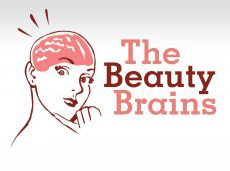How do hair straightening products work? Are they safe? How long do they last?
Show notes
Silicones and ice cream cones
In a clever summer time, non-beauty science twist I quiz Randy about ice cream cones. Listed to the show and test your conical trivia knowledge.
Question of the week: How do keratin hair smoothers work?
Jennifer asks… Will they help my daughter’s hair? Are they bad for hair, I don’t understand how they work. Will they prevent frizz in high humidity Florida weather?
What makes hair curly?
Hair is made of proteins which are long chain molecules. The shape of hair is determined by the chemical bonds that connect these chains together. There are hydrogen bonds and salt bridges which are weak and easily formed and broken. There are also disulfide bonds which are difficult to form and to break.
To visualize how these bonds shape hair, think of a ladder. The sides of a ladder are two different protein chains and the rungs that connect them are like disulfide bonds. In straight hair the rungs hold the sides rigid and perpendicular. The first bond on the left side is connect to the first bond on the right side and so on. But what if you sawed through those ladder rungs? Then you could freely move the two sides of the ladder. You could twist the sides move them up or down, shift them however you like. Then if you glued those rungs back together, you would have changed the shape of the ladder. Now instead of the first bond on the left linked to first bond on the right maybe you’ve moved the sides such that the first bond on left is linked to the second or third bond on the right. That gives the ladder a twisted shape. It’s kind of like turning a straight ladder into a spiral staircase. Straight hair is like the ladder, curly hair is like the spiral staircase. Now let’s talk about three kinds of hair straightening products and how they work.
Surface treatment products (No disulfide bond changes)
First of all – they DON’T work because of keratin. Keratin is the type of protein that hair is made of but just adding keratin to hair doesn’t cause it to change from straight to curly. It’s more accurate to think of these as treatments that smooth keratin rather than as products that smooth with keratin.
Remember these disulfide bonds are NOT easy to change so there’s an inherent tradeoff when you straighten your hair. The more complete and long lasting the straightness, the more damage to your hair. It’s a trade off.
Products that only coat the hair do not break or reform bonds at all. These are least effective but also least damaging. They are temporary and may last through a few shampoos depending on the formula. With current technology, the best you can do is a hair spray resin coating that is unneutralized which means its very hard to wash off.
Bond breaking products
These are the most effective but also the most damaging because they break and reforms the most bonds. They are permanent until hair grows out. (Examples: Relaxing hair with sodium hydroxide or perming hair with Ammonium thioglycolate or Bisulfite
Cross-linking free bonds
This is the class that most so called keratin smoothing treatments fall into. They are effective and only cause minimal to moderate damage. They work by reforming a percentage of free bonds (and reducing a few bonds as well.). They are semi-Permanent because not all bonds are affected and the reformed bonds can break again. The performance depends on degree of curliness of hair. Examples include the following:
- Formaldehyde (methylene glycol)
- Oxoacetamide/Oxoacetic acid/Glyoxylic acid (behaves like formaldehyde)
- Cysteine and Ethanolamine or cysteamine hydrochloride
Why does humidity make hair frizzy?
The inner region of hair, the cortex, consists of two different types of protein. One type is more hydrophilic than the other which means it absorbs water more easily. So when hair is exposed to high humidity, one region absorbs more water than the other which causes the hair fiber to swell unevenly. This uneven swelling twists the hair fiber and causes it to frizz. The degree of frizz depends on several factors: The porosity of your hair, the mixture of the different protein regions, and the strength and completeness of the bonds in the hair.
How can you fight humidity? Water proof hair with a silicone, reconfigure bonds with reactive hair products, and/or lock hair in place with a ton of styling products.
The Beauty Brains bottom line
Keratin smoothers don’t really work by adding keratin. Instead they work by either coating the hair, cross-linking some of the internal bonds, or breaking and reforming a bunch of bonds. By looking at the claims and ingredients you can figure out which is which and you can also pick the best product to keep your hair frizz free.

Buy your copy of It’s OK to Have Lead in Your Lipstick to learn more about:
- Clever lies that the beauty companies tell you.
- The straight scoop of which beauty myths are true and which are just urban legends.
- Which ingredients are really scary and which ones are just scaremongering by the media to incite an irrational fear of chemicals.
- How to tell the difference between the products that are really green and the ones that are just trying to get more of your hard earned money by labeling them “natural” or “organic.
Click here for all the The Beauty Brains podcasts.
